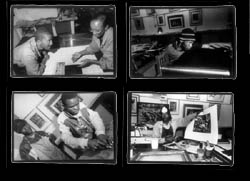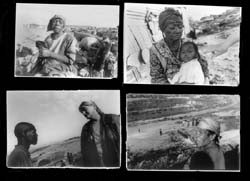| The Artist Proof
Studio, co-founded by Kim Berman, teaches printmaking and papermaking
to black artists from impoverished communities. Studio members coordinate
South Africa’s national Paper Prayers campaign—a program of
educational and cultural events to raise awareness of HIV/AIDS. |
Phutadichaba Qoqizizwe, directed by (Mr.) Linda
Twala, operates a health clinic, community center and meals-on-wheels
program for elderly people in Alexandra township.
Maybe you’ve heard about Alex, as it’s known,
some 3/4 million people, all black, stuffed into one square mile. Like
Soweto, but not as well known. The apartheid government some 20 years
ago attempted to forcibly relocate the inhabitants. They resisted, and
valiantly at that.
A highlight of my experience was befriending a 12 year old orphaned
boy, Freddy Nonkanyana, who was traveling with my guides. He insisted
on carrying my knapsack, dutifully, so as a little surprise I offered
him my giant Nikon to try out. Right in the middle of about 80 people.
He seemed to love the chance, snapped a few, and then we were buddies.
I’d shift cameras to him, let him fly. He’d suggest shots
to me. I showed him everything I was doing, teaching, encouraging. He
led me around the neighborhood, translated, explained. If anything good
visually comes of this experience, in large measure it’s due to
Freddy.
|
This is the Aloes Community, near Port Elizabeth, South Africa—a
thriving industrial city on the beautiful Indian Ocean. But the residents
of Aloes taste, smell, see and absorb industrial detritus. Highly toxic
leachate—a soup percolated from the remains of a myriad of industrial
processes—is trucked here. It seeps and evaporates from holding
pits into the surrounding earth and atmosphere.
Aiding the residents, calling for the closing of the pits, are various
citizens fostering dialog between waste-site managers and neighbors.
They are the Zwartkops River Trust, led by Joan Coutledge and supported
in the United States by the South African Exchange Program on Environmental
Justice (www.igc.org/saepej/).
The photos I tried to make, usually hurriedly, show young people dying
of cancer, children with the tell-tale (in this case) runny nose of
tuberculosis, the widow of an environmental activist who recently succumbed
to what many feel were toxins in his water and air. His name: Nelson
Fezi, leading the community struggle to close the medical waste incinerator
and the Aloe toxic waste sites. The odor here from the Aloes waste sites
reeks of sulfur and other noxious chemicals generated by a substance
called "leachate"—a conglomerate of waste products leaching
thru the soil. Some 60% of this foul substance emanate from the local
tanneries.
At the community of Ibayi, for some 15 years built on a primary
landfill for Port Elizabeth, residents have constructed their shanty
homes on garbage. Methane seeps up from the decomposing wastes and could
cause explosions. Presently, only so-called "clean waste"
is dumped—garden waste and building materials. Men rummage for
bricks and wire that they can sell. In my photos I show the workers,
the shanty residents, their homes, and boys playing soccer. Two women
stopped us—Joan and I were being escorted by Nothi Tabata, director
of the local Community Environmental Network—and asked angrily:
we want to see those photos!
They explained that too often folks like me make photos, promise prints,
never send them. Investigators sample chemicals, formulate recommendations,
and yet not much changes. We promised the photos.
|


